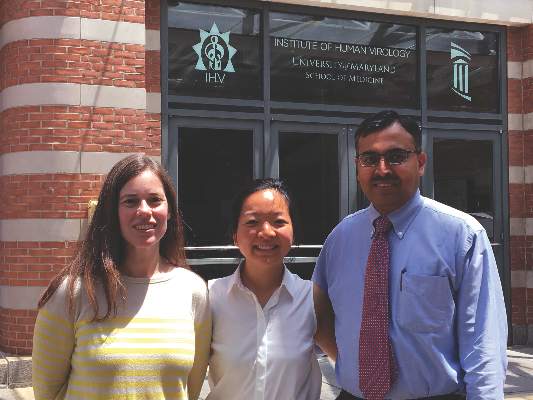Current treatment strategies for chronic hepatitis B virus (HBV) infection seek to suppress viral replication by blocking HBV reverse transcription. When circulating HBV viremia is suppressed, clinical outcomes improve, with slowing of fibrosis and reduced rates of hepatocellular carcinoma. However, when treatment is discontinued, viral replication typically rebounds. This is because nucleos(t)ide (NUC) therapy has no effect on existing HBV cccDNA (covalently closed circular DNA) reservoirs.
A functional cure is defined as the absence of HBV DNA and hepatitis B surface antigen (HBsAg), in the absence of antiviral therapy, with or without the development of protective hepatitis B surface antibody (HBsAb). However, rates of viral clearance are extremely low after therapy with IFN and NUC analogs. Strategies to control HBV replication, purge covalently closed circular DNA (cccDNA) reservoirs, and develop long-lasting protective immunity in patients with chronic HBV infection are desperately needed to achieve a functional cure.
Current investigational approaches to curing HBV fall into two different strategies: targeting the virus directly or manipulating the host immune response to aid in clearance.
Targeting the virus
One of the challenges of treating HBV is the stability of HBV DNA inside infected hepatocytes; supercoiled and sequestered in the host cell nucleus, HBV cccDNA is protected from cellular DNA-sensing machinery. Hepatocytes infected with HBV have a long half-life, serving as a reservoir for HBV reactivation. In addition to preventing, inactivating, or disrupting cccDNA, investigational approaches to target the virus also focus on blocking specific steps in viral replication, including viral transcription, entry into uninfected hepatocytes, capsid assembly, and antigen secretion.
Gene therapy approaches, including zinc finger nucleases (ZFNs), transcription activator-like effector nucleases (TALENs), clustered regularly interspaced palindromic repeat (CRISP-R) applications, and RNA interference (RNAi) technology may be able to inactivate target cccDNA, silencing or disrupting this viral reservoir.
Various investigational drugs are being studied for their ability to interfere with viral entry, encapsidation, or antigen release. Specific interactions between viral membrane proteins and cellular receptors are attractive targets for blocking HBV entry into host cells. Agents that interfere with assembly of the virus particle may prevent the production of infectious virus. Some innovative therapeutic strategies also seek to block the secretion of HBsAg; chronic exposure to HBsAg can lead to T-cell exhaustion, so this strategy may allow the host to develop a more effective anti-HBV adaptive immune response.
Manipulating host response
The second major strategy of novel HBV therapies involves mediating the host response, reversing immune exhaustion, selectively activating innate and/or adaptive immunity through therapeutic vaccination or passive transfer in order to produce a more effective response that results in viral clearance.
The innate immune response, the first line of defense against viral infections, is activated when toll-like receptors (TLRs) on the surface of innate immune cells are engaged, but TLR signaling is downregulated in chronic HBV infection. Stimulating innate immune cells by activating TLRs may accelerate HBV-specific immune reconstitution and help clear HBV in chronically infected individuals. Likewise, blocking the interaction of PD-1 with its ligands (PD-L1/2) may improve the antiviral function of exhausted T cells.
Reversing immune exhaustion will not work if there are no HBV-specific T cells present. Studies have pointed to the clonal deletion of HBV-specific CD8+ T cells as a mechanism of HBV persistence. T-cell responses may be “trained” to recognize infected cells by expressing HBV-specific chimeric antigen receptors (CARs), which are synthetic engineered receptors that can engage cell-surface molecules.
Therapeutic vaccination additionally presents a promising strategy to address HBV-specific T-cell exhaustion by inducing a potent CD4 T-cell response and counteracting immune tolerance against HBV antigens. Yeast-based vaccines, adenovirus vector and engineered vesicular stomatitis virus vectors have shown to be promising platforms that may be capable of eliciting a functional adaptive immune response in patients with chronic HBV, but their use is often limited by preexisting host immunity.
In summary, current therapies for HBV rarely clear or cure infection. A two-pronged approach of targeting viral and host factors may offer the best chance to reverse the immune tolerance, T-cell exhaustion, and persistent viral reservoir associated with chronic HBV infection.
Rebecca Lee is a second-year medical student at the University of Maryland School of Medicine. Eleanor Wilson, MD, is assistant professor in the Institute of Human Virology at the University of Maryland School of Medicine. Shyam Kottilil, MBBS, PhD, is professor of medicine in the Institute of Human Virology at the University of Maryland School of Medicine.





